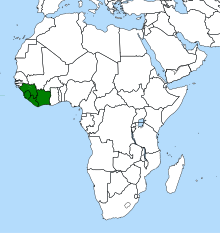Triphyophyllum /ˌtrɪfioʊˈfɪləm/ is a monotypic plant genus, containing the single species Triphyophyllum peltatum of the family Dioncophyllaceae. It is native to tropical western Africa, in Ivory Coast, Sierra Leone and Liberia, growing in tropical forests.
| Triphyophyllum | |
|---|---|

| |
| Scientific classification | |
| Kingdom: | Plantae |
| Clade: | Tracheophytes |
| Clade: | Angiosperms |
| Clade: | Eudicots |
| Order: | Caryophyllales |
| Family: | Dioncophyllaceae |
| Genus: | Triphyophyllum Airy Shaw (1951 publ. 1952) |
| Species: |
T. peltatum
|
| Binomial name | |
| Triphyophyllum peltatum | |

| |
| Triphyophyllum distribution | |
| Synonyms | |
| |
It is a liana, with a three-stage lifecycle, each with a different shaped leaf, as indicated by its Greek name. In the first stage, T. peltatum forms a rosette of simple lanceolate leaves with undulate margins. At times when there is insufficient phosphorus in the soil[1][2] it develops long, slender, glandular leaves, resembling those of the related Drosophyllum, which capture insects; one to three of these leaves in each rosette.[3] In the plant's adult liana form it has short non-carnivorous leaves bearing a pair of "grappling hooks" [4] at their tips on a long twining stem which can become 165 feet (50 meters) in length and four inches (10 cm) thick.[5] T. peltatum is the largest of all confirmed carnivorous plants in the world, but its carnivorous nature did not become known until 1979, some 51 years after the plant's discovery.[6] Its seeds are about 3 inches (7.6 cm) in diameter, bright red in color, disc-shaped, with a peltate stalk emerging from the fruit. Most of the seed's development occurs outside the fruit.[7] The fruit and seed develop from an orange flower with five incurved petals.[8] As the seed dries out, its wide umbrella shape enables it to be transported on the wind.
Triphyophylum peltatum is difficult to cultivate;[1][9] it is cultivated in four botanical gardens: Abidjan, Bonn, Cambridge University and Würzburg[citation needed], and is exceedingly rare in private collections.
Triphyophyllum peltatum is traditionally used in folk medicine. It produces many pharmaceutically active secondary metabolites, some of which have been found to have strong antiplasmodial activity. Some metabolites were found to have antitumoral and anti-multiple myeloma activity.[1]
confirmation of phosphorus starvation to be essential and sufficient
This Caryophyllales article is a stub. You can help Wikipedia by expanding it. |